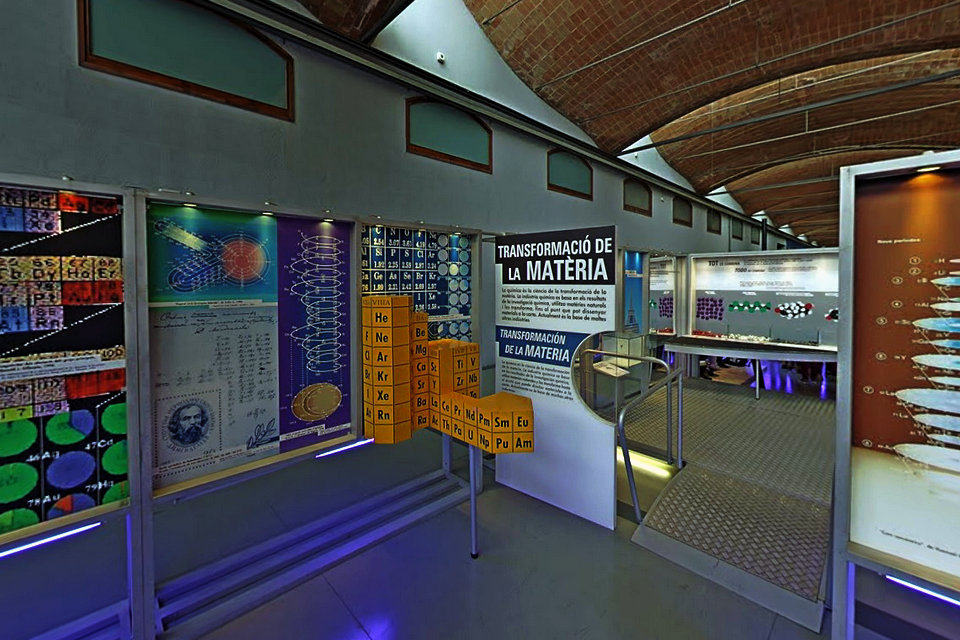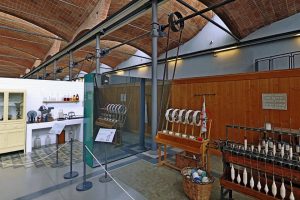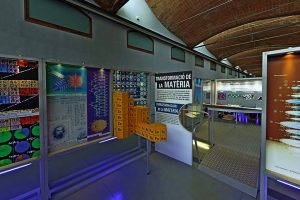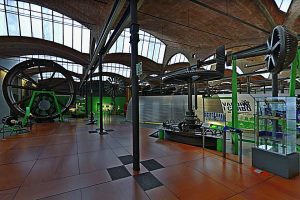معرض يوضح وجود الكيمياء في العالم من حولنا. من أجسادنا إلى التطبيقات المختلفة للكيمياء في الحياة اليومية: المواد والأنشطة اليومية والتغذية والصحة. بدون مساهمات الكيمياء ، كان من شبه المستحيل حل الاحتياجات المتعددة الناتجة عن النمو الديموغرافي أو التركيز على تحسين الرفاهية ومتوسط العمر المتوقع للناس.
يقدم هذا المعرض أحدث التطورات التكنولوجية في مجال الكيمياء ، مثل الألياف الذكية والألياف النانوية والجسيمات النانوية. الاستخدامات الجديدة في الطب ؛ ألياف طبيعية في صناعة السيارات ؛ علاجات جديدة تحسن إدارة النفايات والأساليب البيئية والمستدامة لتخصيب المحاصيل باستخدام مياه البحر.
تم إنتاج “كل شيء كيميائي” بالتعاون مع الجمعية الكاتالونية للكيمياء ، UPC في Terrassa والشركات الرائدة في مختلف قطاعات الكيمياء.
المناطق:
1. أنا كيمياء … لذلك أنا موجود.
2. ما العناصر!
3. تحويل المادة
4. ثورات كبرى في الكيمياء
5. الكيمياء في الحياة اليومية
يسلط الضوء
رقاص الساعة
جهاز فيزيائي يتكون من قاعدة معدنية دائرية مصنوعة من نحاس مذهب مع غطاء أسطواني متصل بجسم أو أسطوانة زجاجية شفافة. يوجد في الجزء العلوي جزء أسطواني آخر يحيط بالزجاج ويدعم قطعة من المعدن المذهب على شكل قوس ، مع البندول أو الكرة الرصاصية المعلقة من النهاية. تم استخدام هذا الجهاز لتجربة ظاهرة جذب وتنافر الأشياء.
مقياس سرعة الدوران RBM
مقياس سرعة الدوران للعربة بواسطة RBM. كانت هذه واحدة من أولى أجهزة قياس سرعة الدوران التي يتم إجراؤها ، وهي غير عادية بشكل خاص لخصائصها. يتم وضع آلية الساعة في عداد السرعة داخل كبسولة معدنية صلبة بشكل خاص. تفتح هذه الكبسولة في نصفين ، مع آلية اللف التي تديرها عجلة في النصف العلوي ، والتي تعمل أيضًا على الإمساك بورقة الورق التي تحدد الفترات الزمنية. تقع بقية الآلية ، بما في ذلك لكمة الورق ، في النصف السفلي.
عجلة بارلو
اخترعها P. Barlow عام 1828 لتوضيح عمل المجال المغناطيسي على تيار كهربائي.
تم تركيب القطعة على قاعدة خشبية مستطيلة بأربعة أقدام. وتتكون من عجلة نحاسية مسننة تدور حول محور أفقي مقولب من معدن مذهب ، يتم غمره أثناء مروره عبر قاعدة حاوية حديدية للزئبق. القطبين من الدائرة الحالية المباشرة ، في معدن مذهب ، متصلان على التوالي بالزئبق والمحور. يخلق المغناطيس مجالًا مغناطيسيًا عاديًا في مستوى العجلة ، ويدور ، ويدور اتجاه الدوران اعتمادًا على اتجاهات المجال المغناطيسي والتيار.
نسخة من الإسطرلاب كارولينجيان
الإسطرلاب هو تمثيل مسطح للكرة السماوية. يمكن استخدام الخطوط المحفورة لتحديد وتوقع تقدم الأجرام السماوية. تم بناء هذا الرقم على وجه الخصوص وفقًا لخط الطول في برشلونة وهو مهم بسبب نظام الترقيم الخاص به ، وذلك باستخدام الحروف اللاتينية التي تتوافق مع الأرقام العربية.
له جانبان ، أحدهما أعمق ، مع قرصين محفورين يعرفان باسم timpani ، حيث يتم تمييز خطوط العرض المختلفة. لكل منهم إسقاط مجسامي في الجزء العلوي من دوائر الكرة السماوية: الأفق النظري ، الأفق البصري ، الزوال ، المداري ، خط الاستواء ، وفي نصف الدائرة السفلي ، خطوط الساعات ذات الأرقام الفردية. العنكبوت متراكب على timpani ، وهو نوع من الرسم البياني المحفور للسماء ، مع إسقاط مسير الشمس وثمانية عشر نجمة (عشرة شمالية وثمانية أسترالية) ، دون أي اسم محفور. يحمل واحد من timpani أسماء روما وفرنسا ، بحروف كبيرة. وفقًا للمؤرخ خوليو سامسو ، توفر هذه الأدلة الواضحة إلى حد ما على مصدرها ، حيث كان إفيرانجا هو الاسم الذي استخدمه العرب قبل القرن الثاني عشر للإشارة إلى الدول المسيحية في شمال شرق شبه الجزيرة الأيبيرية. تشبه الحروف أيضًا تلك المستخدمة في أواخر القرن العاشر في المخطوطات اللاتينية المنتجة في منطقة كاتالونيا.
ماكينة كهرباء رامسدين
آلة كهرباء ساكنة مع قرص زجاجي ، تعرف باسم آلة رامسدين ، على طاولة خشبية. يتكون من قرص زجاجي ثابت مع محور معدني في المركز ، يتم تدويره عن طريق مقبض. عندما يمر الزجاج من خلال دعامتين خشبيتين أو أجزاء تدعم المحور ، يتدحرج السطح على المحامل الموجودة على الدعامات. تعمل الحركة الدوارة على كهربة القرص الزجاجي ، الذي يتلقى شحنة كهربائية إيجابية على كلا الجانبين. الأسطوانة النحاسية المستعرضة الطويلة هي الموصل المعزول ، على قدمين زجاجيين. تحتوي الأطراف البعيدة للأسطوانة على ذراعين مذهبين ، ينتهيان بنقاط تكاد تلمس القرص ، وتفريغ الكهرباء دون فرك.
البيرومتر رباعي
البيرومتر رباعي هو جهاز لقياس تمدد المعادن المعرضة لحرارة اللهب.
وهي مبنية على قاعدة خشبية ، وتتكون من أسطوانة أفقية وسلك معدني وإبرة. تمتلئ الأسطوانة الأفقية بوقود قابل للاشتعال (الكحول) ويتم تطبيق اللهب مباشرة على القضيب المعدني ليتم قياسه.
موازين الميزان
مقاييس التوازن هذه ، التي تتكون بشكل أساسي من رافعة بأذرع متطابقة ، هي جهاز يستخدم لقياس كتلة جسم ما مقارنة بوزن جسم آخر من كتلة معروفة.
ما يمكن استنتاجه من استخدامه هو أن الوزن المعلق على أذرع مختلفة يساوي عكس نسبة مسافاته إلى نقطة الدعم.
تم استخدام مقاييس التوازن هذه للتجريب والتوضيح لأغراض تعليمية.
المتحف الوطني للعلوم والتكنولوجيا في كاتالونيا
المتحف الوطني للعلوم والتكنولوجيا في كاتالونيا (mNACTEC) هو واحد من ثلاثة معترف بها من قبل برلمان متاحف كاتالونيا الوطنية. مهمتها هي أن تظهر بشكل دائم تنفيذ وتطوير التقدم العلمي والتقني في كاتالونيا ، والتطبيق الصناعي وخاصة مشاركتها وتأثيرها الاجتماعي.
المتحف الوطني للعلوم والتكنولوجيا في كاتالونيا هو نتاج التراث الغني والمطول للابتكار والمعرفة العلمية والتقنية ، والتطبيق الصناعي لهذا ، كما تم تطويره في هذا البلد على مر القرون. على الرغم من أن خطط متحف مخصص لنشر المعرفة العلمية والتقنية ، والتطوير المهني في هذين المجالين والحفاظ على أهم السجلات المادية للإبداع الفني للبشرية ، وأهم الأشياء التي تم اختراعها أو تصنيعها في هذا البلد ، يعود تاريخه أصلاً إلى أوائل القرن العشرين ، ولم يكن حتى عام 1984 أن يتشكلوا في شكل هذا المتحف التاريخي الثقافي والاجتماعي.
على مدى 35 عامًا ، نجحت mNACTEC وهيكلها الإقليمي ، المرتبط ارتباطًا وثيقًا بالمجتمع الصناعي الكاتالوني ، كعنصر من عناصر الهوية والتركيز الوطنيين ، اللامركزية ، والمبتكرة ، والمنفذة إقليمياً وبأقصى عائد وتأثير اجتماعي ، في وضع نفسها على أنها الرائد والنموذج الدوليان يقدمان التفرد والخصوصية والأثر الاجتماعي للثقافة العلمية والتقنية والصناعية في كاتالونيا. على الرغم من الصعوبات الاقتصادية التي تجد الدولة نفسها فيها ، فإن mNACTEC يحافظ على ويدعم ويدعم نمو هذا المتحف الهام والتراث والمشروع الثقافي والاجتماعي مع أهداف جديدة وتوقعات أكبر وجرعة أكبر من التجدد والاهتمام المتجدد.
نحن في لحظة تغيير اجتماعي يجبرنا على تركيز كل جهودنا في تعزيز المساحات الموجودة ، وتحديث برمجة المتحف ، وتخطيط مبادرات جديدة ، وضمان الوصول إلى هيكل مناسب ، وتحديث وتوسيع الخطاب الأثري للمنطقة النظام عندما يكون قابلاً للتطبيق ، وتشجيع المشاريع الجديدة التي توفر الحوافز التي تتيح لنا أيضًا أن نصبح متحفًا وطنيًا ملحوظًا في المتاحف الجديدة للقرن الحادي والعشرين. يجب أن يكون متحفًا ديناميكيًا حديثًا يجب أن يكون له بالضرورة مشاركة مباشرة كبيرة في مجتمعنا المعاصر دون نسيان دوره المهم في استعادة وحفظ وتثمين التراث العلمي والتقني والصناعي لثقافة كاتالونيا دون نسيان قوة محركنا ودفعه الناس الذين ، من خلال جعل هذا التراث خاص بهم ، يحولون mNACTEC إلى مشروع حي يخدم ويعزز “روح” هذا المجتمع ، يذكرنا من أين أتينا ، وما نحن عليه وأين نريد أن نذهب.








